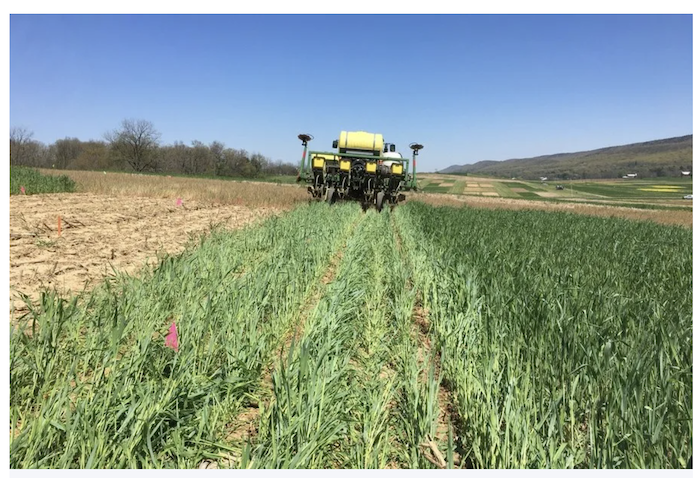For the past two years, we have been participating in a multi-regional U.S. Soybean Board funded experiment that is investigating the effects of planting green on no-till soybean production and management of multiple-resistant waterhemp populations. Planting green is the delay of cover crop termination until after cash crop planting, which is a departure from the standard practices of terminating a cover crop 10-14 days prior to planting. Our coordinated project focused on no-till soybean (30" row spacing; Enlist system) preceded by cereal rye (60 lb/ac) that was sown after field corn. Treatments included:1. soybean planting date[early (May 1-7) vs. late (May 21)];
2. cereal rye termination timing[no cover crop vs. standard cereal rye termination (14 d pre-plant; DPP) vs. planting green (cereal rye terminated 1 DAP]; and3. PRE residual herbicide:[no PRE residual herbicide inputs vs. PRE program (FierceÒ)]. We roll-crimped cereal rye as a residue management tactic using integrated ZRX roller-crimpers and employed minimal row cleaning at the late soybean planting date. All treatments received a POST application of Liberty + Enlist One to provide control of emerged plants and Warrant (acetochlor) to provide overlapping soil residual activity. POST applications were timed to when waterhemp reached a 4-inch height.Here we briefly review key findings from our Pennsylvania location(Table 1). The story that emerged at Rock Springs, PA was driven by differences between years (2020-21 vs. 2021-22). In 2020-21, a very seasonable fall and spring resulted in significant cereal rye biomass production (> 4 tn/ac), whereas more typical cereal rye biomass production (1.5 - 2 tn/ac) was observed in 2021-22.Summary
Our results suggest that planting green can improve waterhemp management by reducing recruitment and delaying the timing of POST herbicide applications when high biomass levels are realized. However, planting green will need to be employed with 2-pass herbicide programs (PRE/POST) when more modest biomass levels (<2 tn/ac) are achieved. Soybean yielded similarly across early and late planting dates and across varying levels of cereal rye biomass production in our 2-yr study. However, it will likely be necessary to make planter modifications, including residue management tools, to consistently achieve adequate soybean stands in varying levels of cereal rye residues.Click here for more Industry News.








